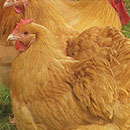Cochin Chickens
Breed: Cochins (pronounced ‘coach-ins’)
Temperament: docile, gentle
Cost: $150.00
Maintenance: low-medium
Lifespan: 8-10 years
Recommended for: breeders and families
History
Cochins (pronounced ‘coach-ins’) are thought to have been developed in the Shanghai district of China more than 150 years ago. They were bred for their excellent laying and meat producing capabilities. Cochins were imported to England and America in 1845 where they started a chicken ‘gold-rush’. Their supposed meat and laying abilities encouraged some people to make large investments in the breed. To meet this demand prolific breeding occurred from a fairly small stock. This reduced the utility (meat production and laying) of the breed and, when bird size and egg laying capabilities did not live up to expectations, the breed fell from popularity. Today they are known as an exhibition breed with average utility. In Australia the breed is considered very rare.
Appearance
Cochins are a large breed with distinctive plumage with a profusion of soft feathering particularly on the feet, which gives them a large round plump appearance. They have lots of long soft feathers with down fibre in the under fluff. Females have a prominent development of feathers at the base of their tails called a cushion.
The Cochin breed comes in a variety of colours including brown, barred, black, buff, golden-laced, partridge, silver laced and white. However in Australia at present, they are only available in buff. Cochins also come in a bantam variety.
Temperament
Cochins are gentle, quiet and docile. The bantam variety reportedly make excellent pets for kids and are apparently the easiest of chickens to tame. They are approachable and get along with people well. They are extremely broody and stubborn mums and will sit for long periods of time even if there are no eggs. They like to roam around the yard but they cannot fly very well.
Breeding and utility
Cochins lack the quick growth, efficient egg production, and cross bred vigour of modern commercial strains but breeders say they possess better utility than most other historical, rare and ornamental breeds. Cochins are considered medium layers, but they lay a small egg in comparison to body size. Breeders say the Cochin can be used as an egg producer and when fully grown and well looked after they can be eaten. Cochins are great mums and can incubate a large number of eggs. However they are a bit clumsy and may stumble over or sit on new offspring. Breeders say they can allow hens to incubate their own eggs during breeding and can even add eggs from other hens to the clutch. If allowed to hatch eggs, Cochins are more than capable of raising their chicks.
Maintenance and care
The foot feathering of Cochins must be maintained if you want to avoid unsightly dirty stains. For Cochins that free range, do this by clipping the long feathering from around the legs and feet when necessary (painlessly for the bird). Cochins that are kept in a dry, well-protected enclosure with soft rice-hull or fine wood shavings to walk on will not get dirty. This also aids in protecting the foot feathering from breakage if the birds are to be exhibited. It is vital that Cochins are protected from heat in the summer months. They cope better in cold climates due to their thick and soft plumage. If the weather is very hot (for example days in the mid 30s and above), an occasional spray of water from a bottle with a mist nozzle will cool the birds. They must have fresh, clean and cool water available and they should be fed a balanced diet with a high protein level. Added vitamins and precautionary medications for worm and disease problems are beneficial for most rare breeds and pure blooded poultry. Watch birds carefully for any signs of illness or distress as death may occur quite quickly. Cochins can free range during the day, but should be provided with shelter and nesting spots.
Health and lifespan
If kept well fed and protected, a pet Cochin should live between 8-10 years. In general the productive life of a breeding chicken is only about 2-3 years and most serious breeders will only keep unusual or valuable birds for longer. All poultry is subject to disease and a vet can give instructions about vaccination and treatment.
Recommended for
According to breeders Cochins make great companions and pets because of their calm and gentle temperament, but the birds are currently more suited to breeders because of the high cost. Children should not be left unsupervised with any pet.
More information
We filmed our story with Edan Montgomery in Victoria. It is important to note that poultry breeders do not have to possess supporting documentation regarding the origins of a bird (such as a pedigree required for cat or dog breeds). If a bird has the physical characteristics to meet a breed standard then it is deemed a member of that breed. Edan’s birds are not direct descendants of the original Cochins bred in China and then Europe.
Edan Montgomery
Phone: (03) 9738 2885
Email:[email protected]



